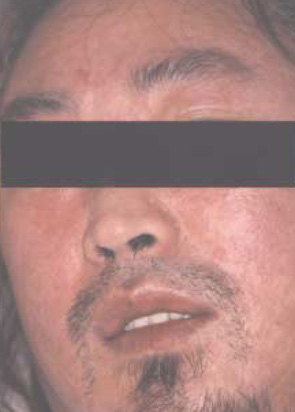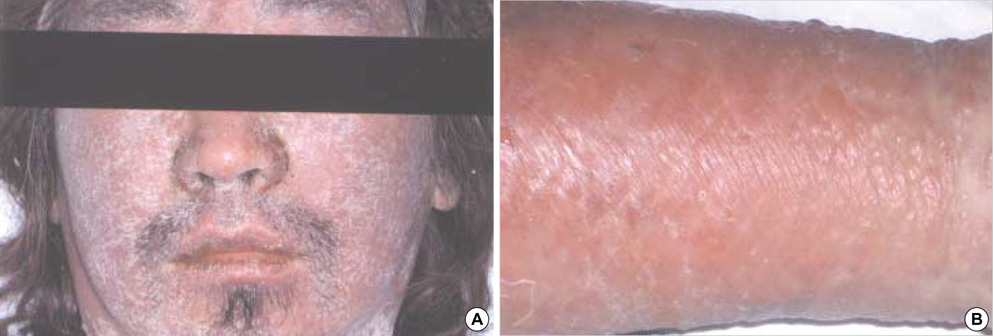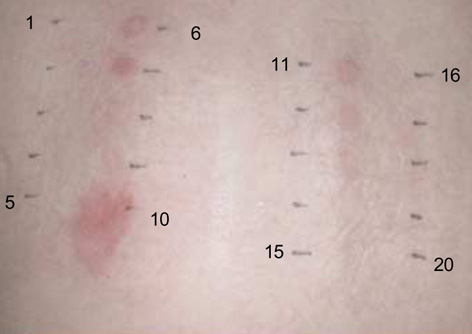J Korean Med Sci.
2006 Aug;21(4):768-772. 10.3346/jkms.2006.21.4.768.
Drug Hypersensitivity to Previously Tolerated Phenytoin by Carbamazepine-induced DRESS Syndrome
- Affiliations
-
- 1Department of Internal Medicine, Inha University College of Medicine, Incheon, Korea. cwkim1805@inha.ac.kr
- 2Department of Dermatology, Inha University College of Medicine, Incheon, Korea.
- 3Department of Neurology, Inha University College of Medicine, Incheon, Korea.
- KMID: 2157838
- DOI: http://doi.org/10.3346/jkms.2006.21.4.768
Abstract
- Drug rash with eosinophilia and systemic symptoms (DRESS) syndrome associated with anticonvulsant drugs is a rare but potentially life-threatening disease that occurs in response to arene oxide producing anticonvulsant such as phenytoin and carbamazepine. There have been many reports of cross reactivity among the anticonvulsants upon first exposure to the offending drugs. However, there has been few data describing the development of DRESS syndrome after switching medication from previously well-tolerated phenytoin to carbamazepine, and the induction of hypersensitivity to phenytoin by DRESS to carbamazepine. We experienced a case of a 40-yr-old man who had uncontrolled seizure that led to the change of medication from the long-term used phenytoin to carbamazepine. He developed DRESS syndrome after changing the drugs. We stopped carbamazepine and restored phenytoin for seizure control, but his clinical manifestations progressively worsened and he recovered only when both drugs were discontinued. Patch tests with several anticonvulsants showed positive reactions to both carbamazepine and phenytoin. Our case suggests that hypersensitivity to a previously tolerated anticonvulsant can be induced by DRESS to another anticonvulsant, and that the patch test may be a useful method for detecting cross-reactive drugs in anticonvulsant-associated DRESS syndrome.
Keyword
MeSH Terms
Figure
Cited by 2 articles
-
Drug Rash with Eosinophilia and Systemic Symptoms (DRESS) Syndrome Induced by Celecoxib and Anti-tuberculosis Drugs
Joo Ho Lee, Hye-Kyung Park, Jeong Heo, Tae Oh Kim, Gwang Ha Kim, Dae Hwan Kang, Geun Am Song, Mong Cho, Dae Sung Kim, Hwal Woong Kim, Chang Hun Lee
J Korean Med Sci. 2008;23(3):521-525. doi: 10.3346/jkms.2008.23.3.521.Hypersensitivity reaction to aspirin accompanied by severe eosinophilia in a child with history of Kawasaki disease
In Suk Sol, Myung Hyun Choi, Min Jung Kim, Yoon Hee Kim, Hee Seon Lee, Yoon Ki Han, Ki Hwan Kim, Kyung Won Kim, Myung Hyun Sohn, Kyu-Earn Kim
Allergy Asthma Respir Dis. 2014;2(2):142-145. doi: 10.4168/aard.2014.2.2.142.
Reference
-
1. Bocquet H, Bagot M, Roujeau JC. Drug-induced pseudolymphoma and drug hypersensitivity syndrome (Drug Rash with Eosinophilia and Systemic Symptoms: DRESS). Semin Cutan Med Surg. 1996. 15:250–257.
Article2. Jee YK, Kim WK, Kim JS, Kim YY, Cho SH, Min KU, Kim YK, Song SH. A case of anticonvulsant hypersensitivity syndrome induced by carbamazepine. Korean J Allergy. 1995. 15:90–95.3. Park SJ, Kang SB, Lee SH, Jung DY, Yoo JH, Kim JY, Park IW, Choi BW. A case of anticonvulsant hypersensitivity syndrome with pseudolymphoma induced by carbamazepine. J Asthma Allergy Clin Immunol. 2001. 21:657–661. [in Korean].4. Kim JW, Kim JS, Kim KJ. A clinical observation of drug hypersensitivity syndrome and serologic and molecular genetic analyses of human herpesvirus-6 reactivation. Korean J Dermatol. 2005. 43:143–150.5. Allam JP, Paus T, Reichel C, Bieber T, Novak N. DRESS syndrome associated with carbamazepine and phenytoin. Eur J Dermatol. 2004. 14:339–342.6. Klassen BD, Sadler RM. Induction of hypersensitivity to a previously tolerated antiepileptic drug by a second antiepileptic drug. Epilepsia. 2001. 42:433–435.7. Kaur S, Sarkar R, Thami GP, Kanwar AJ. Anticonvulsant hypersensitivity syndrome. Pediatr Dermatol. 2002. 19:142–145.
Article8. Galindo PA, Borja J, Gomez E, Mur P, Gudin M, Garcia R, Encinas C, Romero G, Garrido JA, Cortina P, Feo F. Anticonvulsant drug hypersensitivity. J Investig Allergol Clin Immunol. 2002. 12:299–304.9. Conilleau V, Dompmartin A, Verneuil L, Michel M, Leroy D. Hypersensitivity syndrome due to 2 anticonvulsant drugs. Contact Dermatitis. 1999. 41:141–144.
Article10. Descamps V, Bouscarat F, Laglenne S, Aslangul E, Veber B, Des-camps D, Saraux JL, Grange MJ, Grossin M, Navratil E, Crickx B, Belaich S. Human herpesvirus 6 infection associated with anticon-vulsant hypersensitivity syndrome and reactive haemophagocytic syndrome. Br J Dermatol. 1997. 137:605–608.
Article11. Knowles SR, Shapiro LE, Shear NH. Anticonvulsant hypersensitivity syndrome: incidence, prevention and management. Drug Saf. 1999. 21:489–501.12. Shear NH, Spielberg SP. Anticonvulsant hypersensitivity syndrome, in vitro assessment of risk. J Clin Invest. 1988. 82:1826–1832.
Article13. Vittorio CC, Muglia JJ. Anticonvulsant hypersensitivity syndrome. Arch Intern Med. 1995. 155:2285–2290.
Article14. Kleier RS, Breneman DL, Boiko S. Generalized pustulation as a manifestation of the anticonvulsant hypersensitivity syndrome. Arch Dermatol. 1991. 127:1361–1364.
Article15. Nashed MH, Liao L. Possible atypical cross-sensitivity between phenytoin and carbamazepine in the anticonvulsant hypersensitivity syndrome. Pharmacotherapy. 2001. 21:502–505.
Article16. Wilkinson DS, Fregert S, Magnusson B, Bandmann HJ, Calnan CD, Cronin E, Hjorth N, Maibach HJ, Malalten KE, Meneghini CL, Pirila V. Terminology of contact dermatitis. Acta Derm Venereol. 1970. 50:287–292.17. Devos SA, Van Der Valk PG. Epicutaneous patch testing. Eur J Dermatol. 2002. 12:506–513.18. Pelekanos J, Camfield P, Camfield C, Gordon K. Allergic rash due to antiepileptic drugs: clinical features and management. Epilepsia. 1991. 32:554–559.
Article19. Barbaud A, Goncalo M, Bruynzeel D, Bircher A. European Society of Contact Dermatitis. Guidelines for performing skin tests with drugs in the investigation of cutaneous adverse drug reactions. Contact Dermatitis. 2001. 45:321–328.20. Houwerzijl J, De Gast GC, Nater JP, Esselink MT, Nieweg HO. Lymphocyte-stimulation tests and patch tests to carbamazepine hypersensitivity. Clin Exp Immunol. 1977. 29:272–277.21. Silva R, Machado A, Brandao M, Goncalo S. Patch test diagnosis in carbamazepine erythroderma. Contact Dermatitis. 1986. 15:254–255.
Article22. Alanko K. Patch testing in cutaneous reactions caused by carbamazepine. Contact Dermatitis. 1993. 29:254–257.
Article23. Puig L, Nadal C, Fernandez-Figueras MT, Alomar A. Carbamazepine-induced drug rashes: diagnostic value of patch tests depends on clinicopathologic presentation. Contact Dermatitis. 1996. 34:435–437.
Article24. Jones M, Fernandez-Herrera J, Dorado JM, Sols M, Ruiz M, Garcia-Diez A. Epicutaneous test in carbamazepine cutaneous reactions. Dermatology. 1994. 188:18–20.
Article25. Lee AY, Kim MJ, Chey WY, Choi J, Kim BG. Genetic polymorphism of cytochrome P450 2C9 in diphenylhydantoin-induced cutaneous adverse drug reactions. Eur J Clin Pharmacol. 2004. 60:155–159.26. Galindo PA, Borja J, Gomez E, Mur P, Gudin M, Garcia R, Encinas C, Romero G, Garrido JA, Cortina P, Feo F. Anticonvulsant drug hypersensitivity. J Investig Allergol Clin Immunol. 2002. 12:299–304.27. Leeder JS, Riley RJ, Cook VA, Spielberg SP. Human anti-cytochrome P450 antibodies in aromatic anticonvulsant-induced hypersensitivity reactions. J Pharmacol Exp Ther. 1992. 263:360–367.28. Leeder JS. Mechanisms of idiosyncratic hypersensitivity reactions to antiepileptic drugs. Epilepsia. 1998. 39:Suppl 7. 8–16.
Article
- Full Text Links
- Actions
-
Cited
- CITED
-
- Close
- Share
- Similar articles
-
- A Case of Carbamazepine-induced DRESS Syndrome
- A Case of Anticonvulsant Hypersensitivity Syndrome Induced by Carbamazepine
- A Case of Drug Rash with Eosinophilia and Systemic Symptoms Associated with Valproic Acid and Olanzapine Treatment in Patient with Bipolar Disorder
- Clinical Study of Drug Rash with Eosinophilia and Systemic Symptoms (DRESS) on Drug Eruption Patients Over the last 10 years (1995-2004)
- A case of carbamazepine-induced anticonvulsant hypersensitivity syndrome expressing eosinophilic pneumonia




